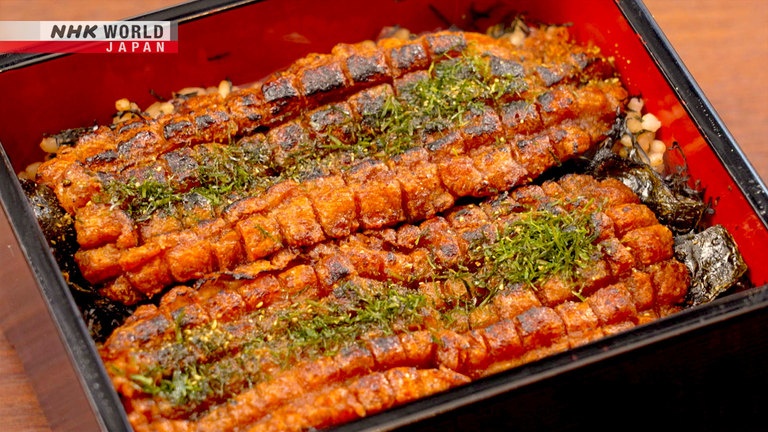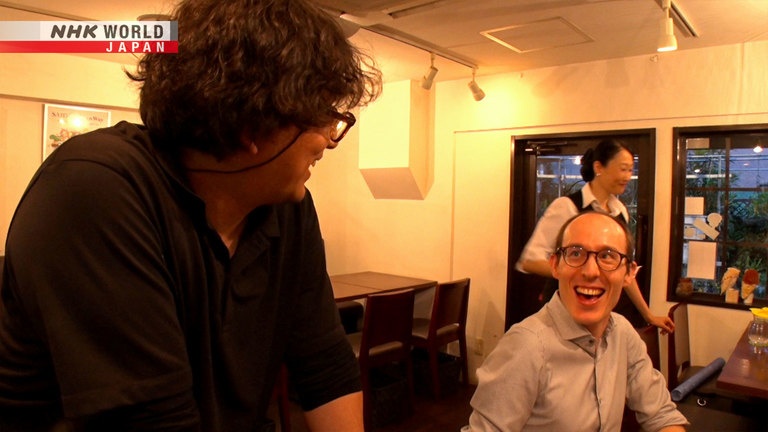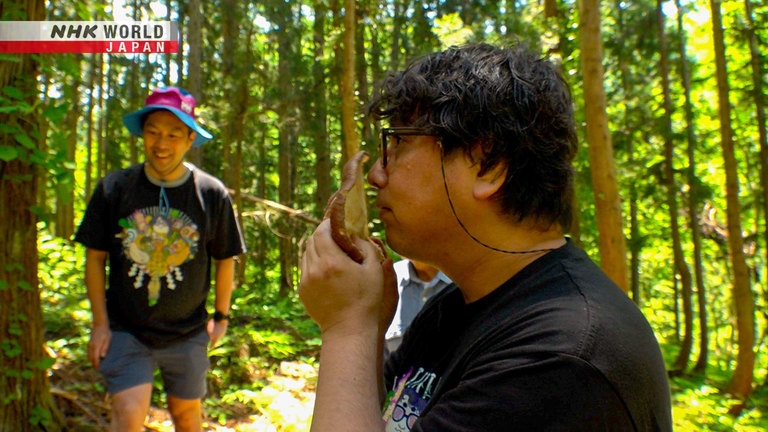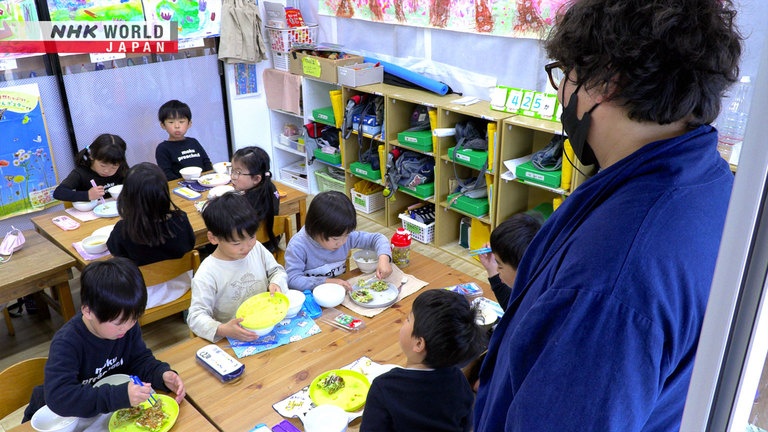Vegan Washoku Chef - Kusumoto Katsumi
A restaurant in Tokyo emerged as the top-rated business on a popular online guide carrying consumer ratings for over 110 thousand vegan restaurants worldwide. And as well as being entirely plant-based, owner Kusumoto Katsumi's menu also caters to those with faith-based dietary restrictions or allergies by eschewing alcohol and artificial ingredients. This time on FRONTRUNNERS, we follow a chef promoting a truly borderless approach to traditional Japanese cuisine.




Transcript
FRONTRUNNERS
Japanese food can be limiting for visitors,
as there are so few vegan-friendly places.
Delicious. This vegan food is very nice.
- How did he capture the flavor so well?
- It is very authentic.
Wow!
The aim is to inspire diners to try, and to make sure they enjoy it.
Vegan washoku chef
Kusumoto Katsumi
Tokyo's upmarket Jiyugaoka district.
This ivy strewn building is home to
one of the world's top-rated vegan restaurants.
- One "eel," one mushroom, one miso ramen.
- Got it.
Chef Kusumoto Katsumi's unique approach to traditional Japanese cuisine
adapts orthodox dishes to suit the needs of diverse diners.
What did these customers order?
An all plant-based fried "pork" cutlet.
Meat-free yakitori "chicken" skewers.
And plant-based ramen.
All much-loved Japanese favorites,
recreated entirely without the use of animal products.
And it's not just the presentation.
Everything from flavor to texture to aroma is just like the originals.
In 2020, this restaurant reached the top spot on a popular online guide
with user ratings for over 100 thousand vegan restaurants worldwide.
- Which order's this?
- "Eel."
Globally, vegetarians, vegans,
and those with religious dietary restrictions
make up around one third of the entire human population.
And with vegan, halal, and other options
still limited in Japan compared with many other countries,
international tourists make up a large portion of Kusumoto's diners.
One of his most popular dishes is this plant-based recreation of "unaju."
Traditionally, this dish is made with eel.
Grilled in a rich "tare" sauce and served over rice,
it's an enduringly popular Japanese favorite.
Kusumoto's vegan version subs in tubers like burdock,
"nagaimo" yams, and lotus root.
I can't let you film the ratios.
- Are they secret?
- They are.
The resulting blend is spread onto sheets of dried nori seaweed.
And scored to approximate the appearance of the real thing.
So, now I'm going to grill these. But I can't let you film that either.
- Should we stop filming?
- Yes, please.
Kusumoto's techniques are full of closely guarded secrets.
Finally, a bed of combined brown and sticky rice...
is topped with the faux eel fillets grilled in a smoky aromatic marinade.
It's a plant-based unaju worthy of world number one status.
So what do the diners think?
After the initial surprise, how does the flavor stack up?
Delicious. This is the first time I came. This vegan food is very nice.
Everything, finished.
For a non-vegan... I could eat this. It's like I'm eating normal food.
They've been in Japan for ten days, and say this is their best meal so far.
Thank you!
Kusumoto's ultimate aim is to create dishes
tasty enough to satisfy vegans and non-vegans alike.
Say you have a couple where she's vegan and he's an omnivore,
and they come to us on a date to celebrate her birthday.
If we can't serve a meal that he can enjoy too,
then that can potentially wind up spoiling the occasion for both of them.
We ought to provide meals that can satisfy omnivores too.
So that's my goal as a chef.
Everyday Japanese dishes like ramen,
"karaage," yakitori, "okonomiyaki,"
I strongly believe that, moving forward,
it will be very important
to adapt those items to suit the needs of vegans, too.
A key focus for Kusumoto is the dashi stock
that forms the basis for most Japanese dishes.
For his vegan menu, he uses a mushroom base,
dried and then rehydrated to intensify the flavor.
I air them until they're bone dry.
How long depends on the weather, and the season.
So not just a day, then?
Days upon days.
Conventionally, Japanese stock is made from
dried, smoked skipjack tuna shavings, or "katsuobushi."
But Kusumoto blends various kinds of mushrooms
to recreate the flavor of fish and animal-based stocks.
These are just rehydrated mushrooms,
but how you heat them alters the flavor.
It's all based on careful research and comparison.
The possibilities for these stock blends are endless,
with even factors like region of origin and water quantity coming into play.
For Kusumoto, it's an ongoing process, further refined on a daily basis.
Each stock has a different color.
And of course, different flavors and aromas, too.
I keep careful track of data on which ones taste stronger,
or sweeter, and so on.
And these mushroom stocks are a big part of what sets Kusumoto apart.
Here's your order.
With a baby on the way, this Japan-based Swiss-American vegan couple
have finally managed to get a reservation
for their first visit to Kusumoto's restaurant in two years.
After enjoying their starter...
The next course is plant-based yakitori skewers.
- Here's your vegan yakitori.
- Great!
The texture is so realistic, it's hard to believe it isn't chicken.
And there's an extra surprise in store.
You can eat the "charcoal" too. Yes, it's a new addition.
- All made from vegetables.
- What kind of vegetables?
Try it and see!
Details like this fried yam "charcoal"
all add to the enjoyable dining experience.
Aren't customers surprised?
At first, but that soon turns to delight.
People enjoy those little gimmicks.
After the yakitori comes the much-anticipated vegan eel unaju.
Yeah! This pose, yeah.
This is from two years ago.
Taken here?
That's right. We were here two years ago.
This "eel" is what brought us back here today.
I couldn't wait to try it again.
And is the taste as good as they remembered?
Have you tried real eel?
I have. Before I went vegan.
The real thing is good, too, but this holds its own.
Don't know what it's made from, but it's great.
The meal is rounded off with a raspberry-flavored soymilk mousse.
I don't use any egg white or dairy.
And Kusumoto's sense of fun is once again on display
with a "tree" made from vegan green tea sponge cake.
Here's your raspberry mousse.
A fitting end to this multi-course vegan dinner.
And Kusumoto makes sure to personally see off these two satisfied customers.
Good night.
On his day off, we join Kusumoto on a trip to Nagano Prefecture,
to visit mushroom grower, Kaneko Keisuke.
(Iiyama, Nagano Pref.)
Together, they head deep into the local mountains.
Wow.
Kaneko's enoki mushrooms are grown using locally felled sugi cedar.
Most commercially available enoki are cultured on a substrate
made from dried, ground corn cobs, imported from overseas.
But Kaneko employs a more traditional approach,
using domestic cedar chippings,
for an altogether more flavorful, aromatic end product.
Kaneko-san's enoki are totally different,
even down to the stock they produce.
I use them because they taste so good.
- There's a big mushroom over here.
- Wow.
This passion for mushroom growing makes Kaneko a key partner for Kusumoto.
And that same dedication is currently aiding
the development of another new product.
Kusumoto is in Hiroshima for a meeting with a major food manufacturer.
Together they're working on a vegan-friendly "tonkotsu" soup.
Tonkotsu is a cloudy broth,
typically made by boiling pork and chicken bones.
And tonkotsu ramen has recently been enjoying a global boom in popularity.
In January 2023,
Kusumoto even opened a tonkotsu ramen pop-up restaurant in Los Angeles.
The 1,000 advance reservation tickets quickly sold out,
with a further 2,000 hopefuls
adding their names to the cancellation waiting list.
And the success of this venture
was a sign of Kusumoto's growing reputation overseas.
Like the dishes in his restaurant,
his plant-based take on tonkotsu ramen also relies on mushrooms.
Give it a try.
- How is it?
- It's tonkotsu!
- That unmistakable richness.
- It's just like the real thing.
It captures the pork fat perfectly, even though I know it's plant-based.
There must be some animal in here!
Passing for tonkotsu with Japanese diners
means it'll definitely convince foreigners.
What's Kusumoto like as a person?
What's he like?
Kind of a rulebreaker, in a good way.
He never concerns himself with any sort of obstacles.
And he's always on the hunt for the next exciting challenge.
Straight out of high school,
Kusumoto Katsumi went into the world of French cuisine.
Then, in his early 30s,
he was made head chef of an exclusive, members-only Japanese restaurant.
And there too, his novel, refreshing approach brought considerable success.
But after years of steady progress,
he reached a turning point in his career as a chef.
One customer told me they wanted to bring along some Muslim guests.
And they told me they couldn't eat pork or drink alcohol,
and that even dishes that used cooking alcohol were out.
Back then, I had no idea about dietary restrictions like that,
so I decided to learn more.
He poured all of his expertise into creating
a halal-friendly Japanese course menu for his scheduled visitors.
However...
I messed up.
They left most of the dishes I prepared, weren't into them at all.
They'd take one mouthful and leave the rest.
As a chef, that must have been a shock.
A major shock.
It felt like as soon as I couldn't use fish, or meat, or alcohol,
my dishes weren't even worth finishing.
It was very upsetting.
And it was after that,
that Kusumoto shifted his focus to plant-based "washoku."
Sinking himself into day after day of painstaking trial and error.
Finally, one day, someone said how tasty my dishes were,
and after the meal,
the plates came back with not a scrap of food left on them.
And the joy of that moment truly motivated me.
It's what's kept me going as a chef ever since.
(Himeji, Hyogo Pref.)
- Hello.
- Hi there.
Here, Kusumoto is engaged in yet another initiative.
Once a month, he comes to help out with the meals at this nursery.
It's attended by 240 children aged zero to five.
The challenge here, is food allergies.
- Many allergies this year?
- Some kids with egg or nut allergies.
- No milk allergies?
- Not this year.
- And how many egg allergies?
- Three children.
In fact, the last few decades have seen an increase in infant food allergies,
creating headaches for nurseries like this one.
For kids with allergies,
we use different colored utensils and separate trays,
and seat them separately.
For some, just one nibble from the classmate next to them
and they could go into anaphylaxis and even die.
That makes mealtimes stressful for staff
but the kids don't understand the dangers,
so being isolated can make them feel lonely.
But the risks posed by serious allergies
are so great that there is usually no option
but to isolate these children with their own dedicated menu.
In response, with the aim of giving all children the chance
to enjoy a shared menu together,
principal Uetsuki Kaoru reached out to Kusumoto.
I don't think there's anything wrong with their existing approach.
The key thing is to prevent catastrophe.
But of course,
I'm a pro when it comes to making tasty meals for my restaurant
without the use of certain ingredients.
That's my area of expertise.
That knowhow can help in the struggle against allergies.
And also make lunch even more delicious.
According to research, around 70% of food allergies in Japan
can be accommodated simply by switching to a vegan menu.
Today's main dish is okonomiyaki savory pancakes
without the traditional egg to bind them.
And in place of meat,
Kusumoto uses enoki mushrooms from his trusted supplier in Nagano.
Together, under Kusumoto's guidance,
the kitchen staff efficiently prepare vegan okonomiyaki for all 240 children.
Even the sauce is plant-based.
As is the egg-free mayonnaise.
Yum, very good.
On today's special menu,
everything from the okonomiyaki to the soup and dessert
is entirely free of animal products.
Something smells good!
And today, all the children,
both those with allergies and those without,
can sit together and enjoy their lunch around the same table.
Another challenge is providing food the kids will enjoy.
Even for dishes that adults might love,
children don't always respond the same way.
They'll say "yuck!" right to your face, even to a world-leading chef.
But in Japan, as elsewhere, not all children are fond of vegetables.
How will they respond today?
Let's eat!
Yum!
Yummy!
How is it?
- Really good.
- Thank you!
- This has meat in it.
- Definitely.
Tastes like meat, but it's mushroom!
Good news everyone! We have seconds!
The plant-based okonomiyaki have turned out to be a major hit.
They're loving it.
In Japan there's a saying about "eating from the same pot."
But in my opinion, there's still some work to do
before everyone can enjoy the same food around the same table.
And I want to work towards achieving that.
That's my goal.
As part of his work to promote these ideals,
Kusumoto visits Fukushima Prefecture.
- Isn't it T-shirt weather today?
- It is a bit chilly.
I chose the wrong outfit.
He's here to showcase vegan washoku
to the chefs of the future at this culinary college.
Despite the growing momentum for veganism worldwide,
awareness in Japan remains comparatively low.
But Kusumoto hopes to convey the potential of this new dietary lifestyle.
Put the scallions on top, like so.
And the best way to help students relate
is by letting them taste the dishes for themselves,
starting with Kusumoto's famous tonkotsu ramen.
Yum!
Have you finished already?
It's really good! So good you can't tell the difference.
The UK has a lot of vegetarians and vegans.
So this is a tonkotsu-style ramen that even they can enjoy.
And I have no time for purist takes like "this isn't real tonkotsu."
Because making meat-inspired dishes that everyone can enjoy
is a really valuable market.
And some students are so inspired
that they corner him after the session.
So I tried the soup, and I felt like it had this bamboo-like acidity.
Did you use bamboo shoots in it?
That's a great question.
I use the broth from boiling bamboo shoots,
and it helps to add to the ramen-like flavor.
So there were no actual bamboo shoots in the soup,
but I did use a bamboo-infused broth.
Overturning convention is key.
What were those pork-like notes?
I thought that might be garlic and shiitake...
Is that a trade secret?
It sure is.
Makes sense.
A student like this will go far.
Thank you so much. I really enjoyed today.
It's all about sowing the seeds.
If these young people take an interest in veganism,
with the technical grounding available in Japan,
I think they can definitely put themselves up there
among the world's top chefs.
I want to keep sowing those seeds
and I do feel a big responsibility
to try and keep on inspiring the next generation.
Today really reinforced that.
Kusumoto Katsumi's mission to bring Japanese washoku
up to speed with the global vegan movement continues.
And that journey is also helping to expand
the potential of Japan's age-old culinary traditions.
So, what is it that motivates him as a "frontrunner" in his field?
My diners are from different cultures
and have a variety of dietary restrictions.
I spend time thinking and innovating.
And I prepare new dishes
that I hope will satisfy and delight all of these individuals.
The moments when they tell me they enjoyed the meal,
that this is the flavor that they were looking for,
are unforgettable for me as a chef.
When they say "that was delicious"
or "I didn't know Japanese food could be this good,"
that's a great feeling.
And that's what motivates me.